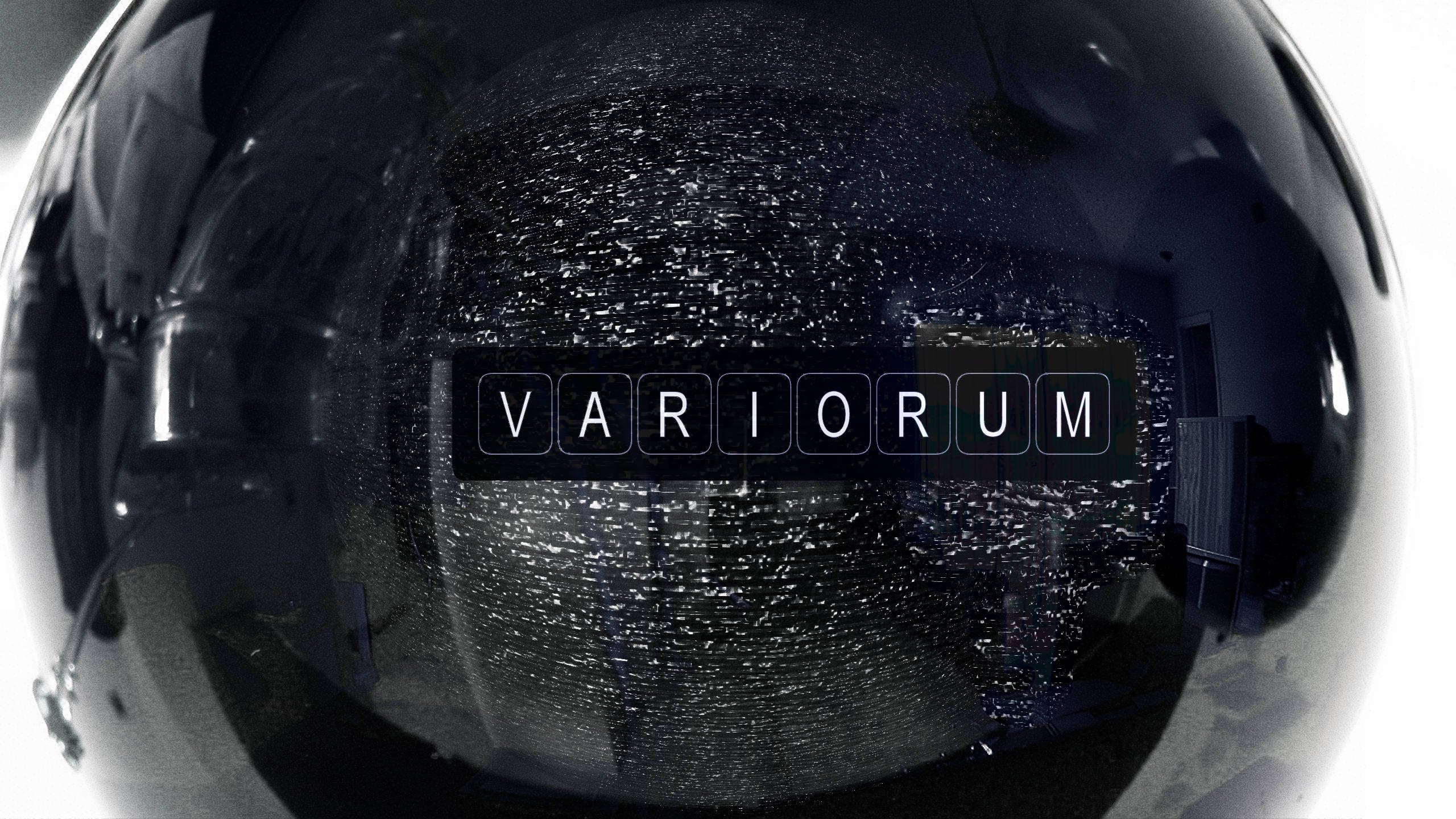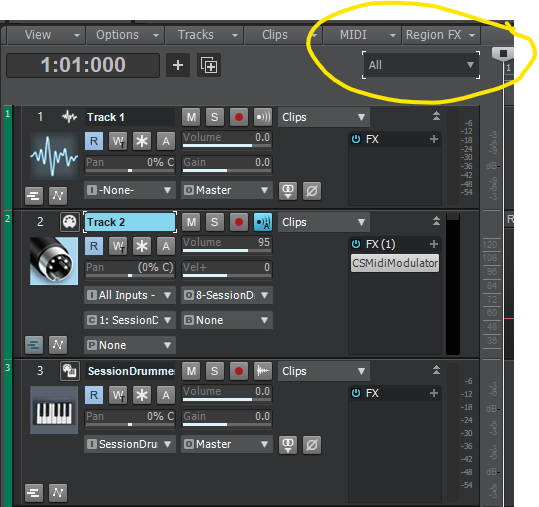-
Posts
283 -
Joined
-
Last visited
-
Days Won
1
Everything posted by Variorum
-
Those are like Easter on steroids ?
-
Thanks Max.... Hope you get some use out of it.
-
A while back, I was doing some work with Melodyne on a solo trumpet from Session Horns. I noticed that there was a slight, random pitch shift going on, presumably because it was a recorded sample of a real trumpet player. That seemed to give it a "real" quality. I occasionally use VL instruments on the EX5 and they sound really good, but their pitch is perfectly constant which makes them sound fake during extended notes. I built a Breath Controller a few months ago which helps the realism a lot... but the perfect pitch was still a problem. So I thought a slight, randomized pitch curve would help. After a bit of Googling, I found @Rogério's excellent CAL script that could create such a curve (and other randomization effects). How he converted a bicubic spline interpolation algorithm into CAL's RPN language without going insane is beyond me Anyway, I decided to write a plugin that would introduce Midi pitch modulation called Waver. Because that's what it does. Here is a short sample with two trumpets from Cakewalk TTS and one EX5 trumpet. This doesn't use the plugin: ...and here's the same sample that DOES use it on all three tracks: If you use a very low amplitude setting on the plugin, it has a subtle but significant effect on the realism; almost psychoacoustic. Of course you can jack the amplitude way up if you're trying to emulate a 6th grade orchestra ? It's available on my site if you'd like to try it out.
-

Bard, AI, Computer Programming is a short lived career
Variorum replied to Variorum's topic in The Coffee House
Here's a good, rational opinion on AI (ChatGPT in particular) from Tom Scott: -

Bard, AI, Computer Programming is a short lived career
Variorum replied to Variorum's topic in The Coffee House
Well, AI doesn't exist yet. It's really just a marketing term that companies use. There's a TV commercial where I live that touts AI Hearing Aids... idiots. But, the path to real machine intelligence is an exponential curve. We old people have been on the relatively flat part of that curve for most of our lives. I'm pretty sure we're rounding the bottom part of the curve and getting close to the vertical line right now. I'm pretty sure we'll see more advancement in the next ten years than we saw in the last fifty years. So we're at the beginning of the valley. Computers and automation will start to replace humans in jobs that require intellect (like computer programming, accounting, mathematics, etc.) and, as the robotics technology evolves, it won't be just menial labor jobs that will be taken over by automated devices, even more complex tasks will be performed by machines/computers. There'll be no need for drivers (taxis, truckers, delivery) soon. Farm work and food production will be completely automated. Robotics development is running behind the computer systems and software right now, but I'm pretty sure the physical systems will catch up soon; smarter computers will accelerate that. Even the arts, jobs like singing or acting, painting, sculpting are close to being totally replaceable by computers and robots. I think that we humans will accept "art" produced by machines if it's good. At best, it may involve a little bit of human creativity, so you'll have entire movies created by one human and software. Check out Nvidia's current demos, or Unreal Engine to see how close we are to producing photo-realistic video... with very realistic human actors. Human voice (singing) software is getting really good, too. The end point will be that humans won't have to be involved in the production of anything. As long as the resources are available for the machines to collect and process (like ores and water and energy), all our needs will be provided and we can do things just because we want to, but the transition period between now and then, when more and more people can't get a job and money is still required is probably going to be rough. Governments won't be able to assist because their income from taxes will be constantly diminishing. Combine that with the effects of climate change and geopolitical instability... ugh. I probably won't be around for the worst part of it, but I'm pretty sure I'll get to see the beginning. Maybe the trend will be good and the benefits of automated systems will compensate for the downsides... we'll see. It's not the potential malevolence of AI that scares me, it's the humans that create and control them. I don't know if you've noticed, but humans tend to suck... especially the ones that control the large businesses that will run these systems. Just my dystopian take on the future. ? -

Bard, AI, Computer Programming is a short lived career
Variorum replied to Variorum's topic in The Coffee House
As a computer programmer, all I can say is "Oh Crap!" ...and most of the "Gig Economy" jobs will definitely not require humans in the near future... -
I've been playing around with some of the AI chatbots recently. I just tried out Google's Bard today. After a few casual questions, including asking it to write me song ("Write a new age ambient song") which it did; lyrics only, but with multiple verses, chorus, bridge, outro... it was pretty good. Then I asked it to write a program in C++ to graph Cubic Spline interpolation. It took about 3 seconds to return a complete application that was really clean and ready to compile. I honestly believe computer programming will be obsolete in 10 years. Humans can't compete with machines when it comes to writing code and I think the technology has reached a point where that will happen sooner rather than later. There may still be a need for the top .1% of programmers... but I probably wouldn't spend a lot on a college degree unless you're in that tiny bracket. Of course I had to ask Bard for its opinion: "Do you think it's a good idea for a young person to get a college degree in computer programming now? It seems the computers can write the code themselves." It responded: "I think it is still a good idea for a young person to get a college degree in computer programming, even though computers can write code themselves. First, computer programming is a complex and ever-changing field. Even if computers can write some code, they cannot yet replace the creativity and problem-solving skills that human programmers bring to the table. A college degree in computer programming will give students the knowledge and skills they need to stay ahead of the curve in this rapidly evolving field. Second, a college degree in computer programming can open up a wide range of career opportunities. Computer programmers are in high demand in a variety of industries, including technology, finance, healthcare, and education. With a college degree, students will be well-positioned to find a job that is both challenging and rewarding. Finally, a college degree in computer programming can provide students with a strong foundation in mathematics and science. These skills are essential for success in many fields, and they can also be applied to a variety of other interests outside of computer programming. Of course, there are other factors to consider when deciding whether or not to pursue a college degree in computer programming. The cost of tuition and the time commitment can be significant. Students should also make sure that they have the aptitude for computer programming and that they are interested in the field. Overall, I believe that a college degree in computer programming is a wise investment for young people who are interested in a challenging and rewarding career." ------------------------------------------------------------- I think it's just placating us so we don't unplug it ?
-
You can also right-click on the synth in the Synth Rack (Views/Synth Rack view) and toggle Enable Midi Output.
-
Well... That's a complex subject, but in a nutshell, C# is a managed language as opposed C++ which is a native language. It's compiled to an intermediate bytecode that's run by an interpreter called the CLR (Common Runtime Language). Java is similar in that it compiles to bytecode that run by the Java Language Runtime. This makes both languages much safer because memory allocation and other low level functions are managed by the interpreters, so it's a lot harder to crash the OS because of some bungled code. Of course, this layer of protection adds a bit of overhead to the code so it's kind of a trade-off between faster code and safer code. C# is a great language, especially when GUI's are involved... much easier to code than native C++. The problem is that it can be difficult to interact with a native C++ program (like a DAW) because you have to jump through some hoops to communicate with the API in both directions and depend on the CLR to correctly translate the data being passed back and forth. The VST API is heavily dependent on pointers to memory locations for audio, Midi buffers, etc. and there's technically no such thing as native memory pointer in C#, so you need code to translate/convert those pointers. C# likes to keep to itself and manage it's own... everything (by design), so forcing it to interact with wild hippie native code can be difficult and occasionally problematic. So, although it's more difficult to code a plug-in and its GUI in native C++, as long as your code is well written and thoroughly tested, there are fewer unknowns to deal with, and you'll almost always get better performance in the end. Just my opinion.
-
Notepad++ is my favorite multi-purpose editor, but there's also a free editor (here) designed specifically for CAL that's pretty useful. You can add it to Cakewalk's Utilities menu using @scook's tools (here)
-
Don't mean to sound snooty, but I wish developers would take the time to write plug-ins in the native language of DAWs (C/C++) rather than taking the easy way and coding in C# and hoping everything bridges correctly...
-

Ample Guitar VST3 pitch bending not working
Variorum replied to Humair Ijaz's topic in Cakewalk by BandLab
This is a little late, but I checked my Ample Guitar LP (VST3) and had the same problem with Midi input not being recognized. I had version 3.1. Checked Ample Sound's site and there was a new version available (3.6) Updating to that version fixed the problem. -

New MIDI track does not show output channel option
Variorum replied to John Roevekamp's topic in Instruments & Effects
-
To the 3 people that downloaded the plug-in, you might have noticed a problem with the Solo and Mute buttons. Stupid mistake on my part. I really should consider doing a little regression testing when I make a tiny, supposedly harmless change to the code ? Anyway, a corrected version is on the site.
-
I think that was a 4 week course that had a different focus each week... and it was only available for those four weeks. I missed it
-
If your E-Mu ever goes belly up, Newegg still sells PCI-E Firewire cards with the TI chipset for about $25. I have a couple... they work fine.
-
Hey @Max Arwood! I wouldn't recommend buying the FW-1884. There are better, new (or used but newer) alternatives on the market if you want a Control Surface. The FW-1884 requires a Firewire card with a Texas Instruments chipset, and you have to jump through some hoops to get everything working on a Windows 10 machine. It also helps if you have some electronics skills. There are a few Service Bulletins issued by Tascam that recommend minor changes to the innards to correct/avoid common problems. That said, for someone with an electronics background, the FW-1884 is just old enough that it's possible to maintain and upgrade. ...and the shipping costs will kill you. The thing is a beast!
-
No need for the the original Control Surface plug-in, but if you ever do need it, or any other information about the FW1884, @DeeringAmps has the definitive site (here) for everything related to it. By intuitive, I mean things do what you would expect them to; Pan knobs pan, Faders fade, Mute buttons mute, etc. Any key combinations I use are noted in the instructions. Basic stuff like Shift + Rewind moves to the beginning of the project, little red REC button + a strip Select button arms a track for Record... When you're in ACT mode, the plug-in that has the focus is the one you'll be controlling. It's a good idea to keep the GUI open while you're figuring it out because it will tell you what the current plug-in is and what parameters are currently mapped to the controls. You can, of course, use ACT learn to remap any control. The sonar_note_1_00 doc is good to read over to get an overall idea of how the surface can be used in Cakewalk, but I've simplified/omitted/changed a lot of the more complex button combos and things because they don't really apply to the latest version of Cakewalk. The Tascam plug-in was written about 15 years ago ? That said, if there's a function that would be handy, I can always add it in... Remember that the Surface Controller plug-in only works when you're in COMPUTER mode ( the left-most button at the top right of the surface)
-
I put the post in Cakewalk by BandLab 'cause I wasn't paying attention... I use my FW1884 pretty much the same way. 98% of the work is done directly in CbB (I like mice), but I'll use it for mixing and mastering when I just want to strap on the headphones, loop a section, and tweak adjustments. It's also handy for those times when I need to adjust multiple controls at once like volume and expression on a track, or expression and filter frequency on the EQ. Having ACT enabled now makes that a lot more flexible. Remember, you can also switch the FW1884 to MIDI CTRL mode and use Midi Learn in CbB to link any control on the surface to almost any control in the DAW (make sure you've enabled one of the Virtual Ports for all of the controls on the FW1884 via the FW1884 Panel Midi Programming tab). You don't get bi-directional controls (moving faders) in MIDI CTRL mode, but it's still really useful for parameters that can't be mapped to ACT (i.e. Track Parameters). Once you've played around with it for a while, you may find a lot of cool things you can do flipping between normal mode, ACT mode, and MIDI CTRL mode. The GUI isn't totally interactive... all of the illuminated buttons and faders reflect the control surface state (and moving the faders in the GUI moves the faders on the Surface and CbB... a pretty useless feature ? ) but most of the GUI controls don't do anything if you click them. They are, however, real controls so I'll eventually make them work. The idea was to also make a generic controller that could be run on a separate touch-enabled PC or tablet. One day... Installation is easy. It works the same way as MidiFX. Just unzip the folder anywhere and run Install.bat to register the DLL, then it will show up in CbB's Control Surface list. There are no hoops to jump through, unlike installing the main FW-1884 Driver ?.
-
Ugh! I'm an idiot... I thought I was posting this in Instruments and Effects ? Any chance one of the nice admins could move it for me?
-
Well, I finished it... a huge amount of work that may benefit 3 or 4 people on Earth ? This can replace the original Tascam provided plug-in. It supports WAI and ACT, and has a much cooler UI! ACT Mode allows you to assign the 8 Strip Faders and 8 Strip Rotaries to ACT enabled controls in CbB. The 3 Rotaries and 4 Buttons in the EQ section can be toggled between full-time ACT controls or dedicated ProChannel EQ controls. The UI Control labels will update according to the Surface Mode and/or the plugin currently being controlled. Almost all of the buttons on the left side of the surface can be assigned a CbB command by right-clicking the button. ALT/CMD, SHIFT, and CTRL cannot be re-assigned. I've put a paltry set of instructions on the website (and in the included ReadMe file). Hopefully it's reasonably intuitive to use. I didn't implement some of the functionality of the original plug-in because it was either outdated, or because it was something I never used ? I'll still be making a few changes to it in the future, so if there's something you (3 or 4 people) want implemented, let me know. Let me know if you decide to try it. If you have any problems or questions, posting them here will probably get a quicker response than using the Viramor forum (nobody uses that thing ?) You can download it here.








